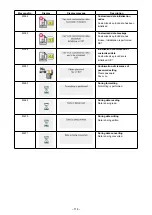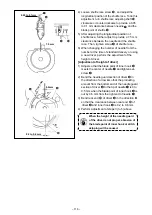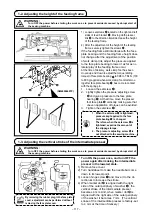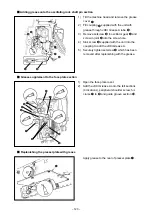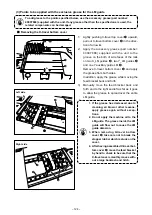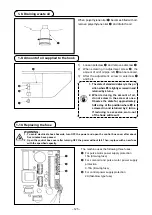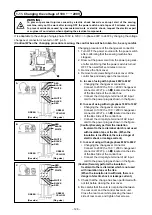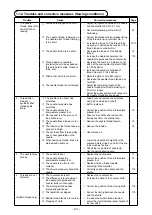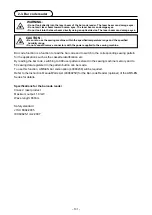
– 128 –
Trouble
Cause
Corrective measures
Page
5. Stitch skipping
often occurs.
①
The motions of the needle
and shuttle are not properly
synchronized.
◦
Correct the positions of the needle and
shuttle.
②
The clearance between the
needle and shuttle is too large.
◦
Correct the positions of the needle and
shuttle.
③
The needle is bent.
◦
Replace the bent needle.
④
The driver excessively bends the
needle.
⑤
Length of needle thread
remaining after thread trimming
is too long. (In the case of stitch
skipping within the 2nd to 10th
stitch from the beginning of
sewing)
◦
Correctly position the driver.
◦
Reduce the thread take-up spring
pressure or increase the thread
tension applied by the thread tension
controller No. 1.
6. The needle
thread comes
out on the wrong
side of the
material.
①
The needle thread tension is not
high enough.
◦
Increase the needle thread tension.
②
The tension release mechanism
fails to work properly.
◦
Check whether or not the tension disc
No. 2 is released during bar-tracking.
③
The needle thread after thread
trimming is too long.
◦
Increase the tension of the thread
tension controller No. 1.
④
Number of stitches is too few.
◦
Turn OFF the thread clamp.
⑤
When sewing length is short (End
of needle thread protrudes on the
wrong side of sewing product.)
◦
Turn OFF the thread clamp.
⑥
Number of stitches is too few.
◦
Use the lower plate, the hole of which
is larger than the presser.
7. Thread end of
the 1st stitch
comes out on
the right side of
the material.
①
Stitch skipping at the 1st stitch
◦
Adjust the hook timing faster by a 1/2
stitch.
②
Intermediate presser is not
properly positioned in terms of
the needle.
◦
Adjust the eccentricity between
intermediate presser and needle so
that needle enters in the center of
intermediate presser.
8. Threads break
at time of thread
trimming.
①
The moving knife has been
improperly position.
◦
Correct the position of the moving
knife.
9. The thread
clamp is
entangled with
needle thread.
①
The needle thread at the sewing
start is too long.
◦
Tighten thread tension controller No. 1
and make the length of needle thread
45 to 55 mm.
10. Uneven length
of the needle
thread
①
The tension of thread take-up
spring is too low.
◦
Increase the tension of the thread
take-up spring.
11. The length of
needle thread
does not
become short.
①
The tension of thread tension
controller No. 1 is too low.
◦
Increase the tension of thread tension
controller No. 1.
②
The tension of thread take-up
spring is too high.
◦
Decrease the tension of thread take-
up spring.
③
The tension of thread take-up
spring is too low and motion is
unstable.
◦
Increase the tension of thread take-
up spring and lengthen the stroke as
well.
12. The knotting
section of bobbin
thread at 2nd stitch
at the sewing start
appears on the
right side.
①
Idling of bobbin is large.
◦
A just the position of the moving knife.
②
The bobbin thread tension is too low.
◦
Increase the bobbin thread tension.
◦
Turn OFF the thread clamp.
13. Wiper fails to
work. (Return is
defective.)
①
Needle entry of the last needle is
the same as that of the sew-
ing start, and the resistance of
thread and cloth is large.
◦
Shift the needle entry point of the last
needle.

